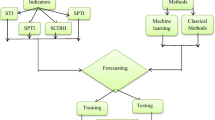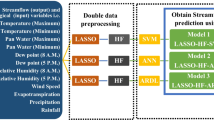Abstract
In this research, a new framework has been introduced for rainfall temporal variability evaluation by using combination of monthly rainfall data sets in three synoptic stations, Principal Component Analysis (PCA), Adaptive Neuro Fuzzy Inference System (ANFIS), Grasshopper Optimization Algorithm (GOA), and Innovative Trend Analysis (ITA) methodology. The first five components were chosen as inputs of the soft-computing models, based on PCA. The GOA was used for training the ANFIS model, in order to estimate the monthly rainfall. The outputs of the ANFIS-GOA were compared to the rainfall estimates by ANFIS-Particle Swarm Optimization (ANFIS-PSO) and ANFIS-Genetic Algorithm (ANFIS-GA). Moreover, various statistical indices, such as mean absolute error (MAE), percent bias (PBIAS) and Nash-Sutcliffe Efficiency (NSE) were used to evaluate the soft-computing models’ performance. Results indicated that ANFIS-GOA had higher accuracy in estimating the rainfall (values of MAE, NSE and PBIAS were 0.21, 0.92 and 0.16 for Mehrabad station, 0.16, 0.94 and 0.14 for Semnan station and 0.24, 0.91 and 0.17 for Noshahr station, respectively) in the testing phase. These values showed significant improvements (67.8%, 21% and 40% for Mehrabad station, 69.2%, 17.5% and 33.3% for Semnan station and 57.1%, 21.3% and 37% for Noshahr station) versus indices related to standalone ANFIS model, which reflected the supremacy and higher accuracy of ANFIS-GOA model in rainfall prediction for different climatic conditions. It was also concluded that the ANFIS-GOA, ANFIS-PSO, and ANFIS-GA models performed superior to the standalone ANFIS-based model, respectively. Furthermore, possible trends in monthly rainfall have been detected by ITA, which is a new graphical model. Results showed significant decreasing trends in January and July for all the rainfall values in Mehrabad station. By comparison of the results obtained from ANFIS and the hybrid models with observed data, it was also concluded that the trends of observed data were close to the ANFIS-GOA predictions.








Similar content being viewed by others
References
Asadnia M, Chua LHC, Qin XS, Talei A (2014) Improved particle swarm optimization–based artificial neural network for rainfall-runoff modeling. J Hydrol Eng 19:1320–1329
Ay M, Kisi O (2015) Investigation of trend analysis of monthly total precipitation by an innovative method. Theor Appl Climatol 120:617–629
Azad A, Farzin S, Kashi H, Sanikhani H, Karami H, Kisi O (2018) Prediction of river flow using hybrid neuro-fuzzy models. Arab J Geosci 11:718. https://doi.org/10.1007/s12517-018-4079-0
Azad A, Manoochehri M, Kashi H, Farzin S, Karami H, Nourani V, Shiri J (2019) Comparative evaluation of intelligent algorithms to improve adaptive neuro-fuzzy inference system performance in precipitation modelling. J Hydrol 571:214–224
Barman M, Dev Choudhury NB, Sutradhar S (2018) A regional hybrid GOA-SVM model based on similar day approach for short-term load forecasting in Assam, India. Energy 145:710–720
Cramer S, Kampouridis M, Freitas AA, Alexandridis AK (2017) An extensive evaluation of seven machine learning methods for rainfall prediction in weather derivatives. Expert Syst Applic 85:169–181
Cramer S, Kampouridis M, Freitas AA (2018) Decomposition genetic programming: An extensive evaluation on rainfall prediction in the context of weather derivatives. Appl Soft Comput 70:208–224
Esteves JT, de Souza RG, Ferraudo AS (2019) Rainfall prediction methodology with binary multilayer perceptron neural networks. Clim Dyn 52:2319–2331
Farzin S, Valikhan Anaraki M (2020) Optimal construction of an open channel by considering different conditions and uncertainty: application of evolutionary methods. Eng Optim. https://doi.org/10.1080/0305215X.2020.1775825
Farzin S, Nabizadeh Chianeh F, Valikhan Anaraki M, Mahmoudian F (2020) Introducing a framework for modeling of drug electrochemical removal from wastewater based on data mining algorithms, scatter interpolation method, and multi criteria decision analysis (DID). J Clean Prod 266:122075
Goyal MK (2014) Monthly rainfall prediction using wavelet regression and neural network: an analysis of 1901–2002 data, Assam, India. Theor Appl Climatol 118:25–34
Guçlu YS (2018) Multiple Şen-innovative trend analyses and partial Mann-Kendall test. J Hydrol 566:685–704
Hashim R, Roy C, Motamedi S, Roy C, Shamshirband S, Petcovic D, Geocic M, Cheng Lee S (2016) Selection of meteorological parameters affecting rainfall estimation using neuro-fuzzy computing methodology. Atmos Res 171:21–30
Hossain MZ, Azad MAK, Karmakar S, Mondal MNI, Das M, Rahman MM, Haque MA (2019) Assessment of better prediction of seasonal rainfall by climate predictability tool using global sea surface temperature in Bangladesh. Asian J Adv Res Reports 4(4):1–13
Jeong C, Shin JY, Kim T, Heo JH (2012) Monthly precipitation forecasting with a neuro-fuzzy model. Water Resour Manag 26:4467–4483
Jiang Z, Li R, Ji C, Li A, Zhou J (2018a) Wavelet analysis-based projection pursuit autoregression model and its application in the runoff forecasting of Li Xiangjiang basin. Hydrol Sci J 63:1817–1830
Jiang Z, Li R, Li A, Ji C (2018b) Runoff forecast uncertainty considered load adjustment model of cascade hydropower stations and its application. Energy 158:693–708
Jiang Z, Wu W, Qin H, Zhou J (2018c) Credibility theory based panoramic fuzzy risk analysis of hydropower station operation near the boundary. J Hydrol 565:474–488. https://doi.org/10.1016/j.jhydrol.2018.08.048
Jumani TA, Mustafa MW, Md Rasid M, Mirjat NH, Baloch MH, Salisu S (2019) Optimal power flow controller for grid-connected microgrids using grasshopper optimization algorithm. Electron 8(1):111
Karaboga D, Kaya E (2019) Adaptive network based fuzzy inference system (ANFIS) training approaches: a comprehensive survey. Artif Intell Rev 52:2263–2293
Kennedy J, Eberhart R (1995) Particle swarm optimization. In: Proceedings of ICNN’95-international conference on neural networks. IEEE, pp 1942–1948
Khoshnevisan B, Rafiee S, Omid M, Mousazadeh H (2014) Development of an intelligent system based on ANFIS for predicting wheat grain yield on the basis of energy inputs. Info Process Agric 1(1):14–22
Lukasik S, Kowalski PA, Charytanowicz M, Kulczycki P (2017) Data clustering with grasshopper optimization algorithm. Federated conference on computer science and information systems (FedCSIS), pp 71–74
MacQueen J (1967) Some methods for classification and analysis of multivariate observations. Proc 5th Berkeley Symp Math Stat Prob 281–297
Mehdizadeh S, Behmanesh J, Khalili K (2018) New approaches for estimation of monthly rainfall based on GEP-ARCH and ANN-ARCH hybrid models. Water Resour Manag 32:527–545
Mirabbasi R, Kisi O, Sanikhani H, Meshram SG (2019) Monthly long-term rainfall estimation in Central India using M5Tree, MARS, LSSVR, ANN and GEP models. Neural Comput & Applic 31:6843–6862
Mirjalili SZ, Mirjalili S, Saremi S, Faris H, Aljarah I (2018) Grasshopper optimization algorithm for multi-objective optimization problems. Appl Intell 48(4):805–820
Ramana RV, Krishna B, Kumar SR, Pandey NG (2013) Monthly rainfall prediction using wavelet neural network analysis. Water Resour Manag 27:3697–3711
Rasam S, Talebkeikhah F, Talebkeikhah M, Salimi A, Keshavarz M (2019) Physico-chemical properties prediction of hydrochar in macroalgae sargassum horneri hydrothermal carbonisation. Int J Environ Anal Chem:1–22
Saremi S, Mirjalili S, Lewis A (2017) Grasshopper optimisation algorithm: theory and application. Adv Eng Softw 105:30–47
Şen Z (2012) Innovative trend analysis methodology. J Hydrol Eng 17:1042–1046
Şen Z (2014) Trend identification simulation and application. J Hydrol Eng 19:635–642
Sudheer C, Maheswaran R, Panigrahi BK, Mathur S (2014) A hybrid SVM-PSO model for forecasting monthly streamflow. Neural Comput & Applic 24:1381–1389
Tukey JW (1991) The philosophy of multiple comparisons. Stat Sci 6(1):100–116
Wang B, Xiang B, Li J, Webster PJ, Rajeevan MN, Liu J, Ha KJ (2015) Rethinking Indian monsoon rainfall prediction in the context of recent global warming. Nat Commun 6:7154
Wu J, Long J, Liu M (2015) Evolving RBF neural networks for rainfall prediction using hybrid particle swarm optimization and genetic algorithm. Neurocomput 148:136–142
Yaseen ZM, Ghareb MI, Ebtehaj I, Bonakdari H, Siddique R, Heddam S, Yusif AA, Deo R (2018) Rainfall pattern forecasting using novel hybrid intelligent model based ANFIS-FFA. Water Resour Manag 32:105–122
Yaseen ZM, Ebtehaj I, Kim S, Sanikhani H, Asadi H, Ghareb M, Bonakdari H, WanMohtar H, Al-Ansari N, Shahid S (2019) Novel hybrid data-intelligence model for forecasting monthly rainfall with uncertainty analysis. Water 11(3):502
Zoveidavianpoor M (2014) A comparative study of artificial neural network and adaptive neurofuzzy inference system for prediction of compressional wave velocity. Neural Comput & Applic 25:1169–1176
Author information
Authors and Affiliations
Corresponding author
Additional information
Publisher’s Note
Springer Nature remains neutral with regard to jurisdictional claims in published maps and institutional affiliations.
Rights and permissions
About this article
Cite this article
Farrokhi, A., Farzin, S. & Mousavi, SF. A New Framework for Evaluation of Rainfall Temporal Variability through Principal Component Analysis, Hybrid Adaptive Neuro-Fuzzy Inference System, and Innovative Trend Analysis Methodology. Water Resour Manage 34, 3363–3385 (2020). https://doi.org/10.1007/s11269-020-02618-0
Received:
Accepted:
Published:
Issue Date:
DOI: https://doi.org/10.1007/s11269-020-02618-0




